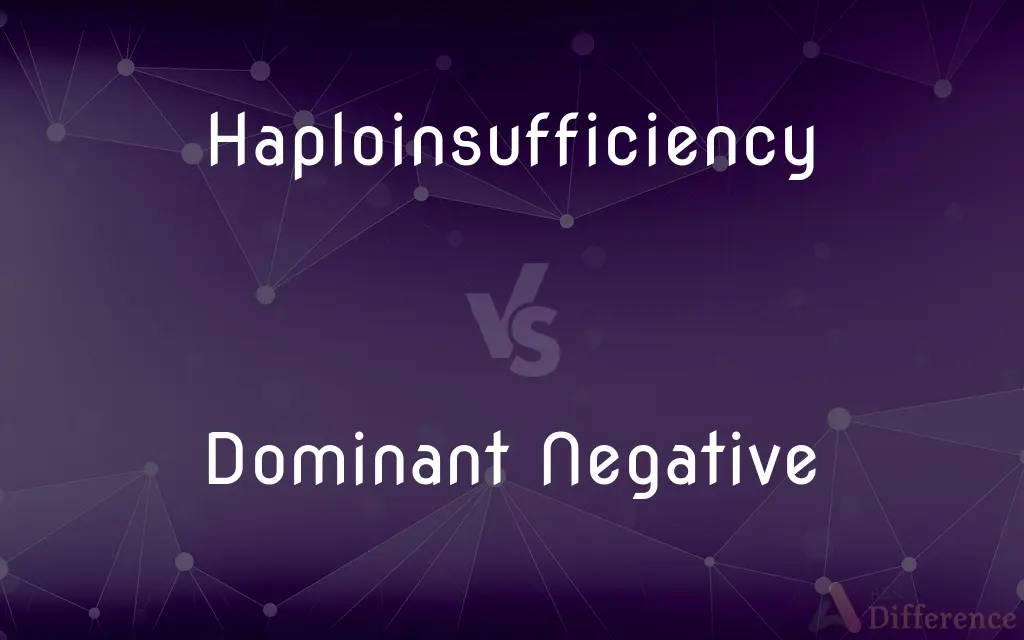Haploinsufficiency vs. Dominant Negative — What's the Difference?
By Tayyaba Rehman — Published on January 30, 2024
Haploinsufficiency occurs when a single gene copy is inadequate for normal function, while dominant negative refers to a mutated gene interfering with the function of a normal gene.

Difference Between Haploinsufficiency and Dominant Negative
Table of Contents
ADVERTISEMENT
Key Differences
Haploinsufficiency is a genetic phenomenon where one copy of a gene is not sufficient to maintain normal function, leading to a phenotype. This typically occurs in cases where a dose-sensitive gene is involved. In contrast, Dominant Negative mutations occur when a mutated gene product antagonizes the function of the wild-type gene product, leading to a dysfunctional phenotype even in the presence of a normal gene copy. This can occur in proteins where the mutated form disrupts the function of the normal protein.
In the context of Haploinsufficiency, the insufficient gene dosage leads to quantitative effects on the phenotype, meaning that the amount of protein produced is not enough for normal function. This can be due to a deletion or a loss-of-function mutation in one of the gene copies. However, in Dominant Negative mutations, the altered gene product typically forms nonfunctional complexes with the normal protein, or otherwise interferes with its normal function, leading to a qualitative change in the activity of the protein.
Haploinsufficiency often results in conditions where the severity of the phenotype is directly related to the level of protein expression. Diseases associated with haploinsufficiency are often autosomal dominant. On the other hand, Dominant Negative mutations can have more severe effects since they can actively disrupt normal protein function, often leading to dominant disorders where the mutated protein exerts a harmful effect independent of the normal allele.
Haploinsufficiency can be mitigated in some cases by upregulating the expression of the remaining normal gene or by gene therapy to add a functional copy. However, addressing Dominant Negative mutations is more challenging, as it requires strategies to specifically inhibit the mutant protein without affecting the normal allele, such as selective degradation of the mutant protein or blocking its interaction with the normal protein.
In summary, Haploinsufficiency is about the insufficient quantity of a gene product, leading to a phenotype due to a dosage effect. In contrast, Dominant Negative mutations involve a mutated gene product that actively interferes with the function of the normal gene product, causing a phenotype through a qualitative effect on the protein's function.
ADVERTISEMENT
Comparison Chart
Genetic Cause
Loss or reduction of one gene copy
Mutant gene product interfering with normal function
Effect on Protein
Reduced quantity of protein
Normal protein's function disrupted by mutant
Phenotype Cause
Due to inadequate gene dosage
Due to the antagonistic effect of the mutant gene
Disease Mechanism
Often results in autosomal dominant disorders
Can lead to more severe dominant disorders
Potential Therapies
Upregulating normal gene, gene therapy
Inhibiting mutant protein, selective degradation
Compare with Definitions
Haploinsufficiency
It describes a condition where one gene copy can't compensate for the loss of the other.
In cases of cystic fibrosis, haploinsufficiency can sometimes be observed.
Dominant Negative
Dominant negative mutations act against and dominate over the wild-type gene product.
Dominant negative mutations in the COL1A1 gene cause a severe form of osteogenesis imperfecta.
Haploinsufficiency
Haploinsufficiency arises from a reduction in gene dosage affecting phenotype.
A single functional copy of the RB1 gene can't prevent retinoblastoma, showcasing haploinsufficiency.
Dominant Negative
Dominant negative refers to a mutation that counteracts the function of the normal gene product.
A dominant negative mutation in TP53 can inhibit normal p53 tumor suppressor function in cancer cells.
Haploinsufficiency
It's a genetic situation where half the normal amount of a gene's product is inadequate.
Haploinsufficiency of the PMP22 gene leads to Charcot-Marie-Tooth disease.
Dominant Negative
Dominant negative involves a mutated protein that forms nonfunctional complexes with the normal protein.
A dominant negative mutation in the KIT gene can lead to dysfunctional mast cells in certain disorders.
Haploinsufficiency
Haploinsufficiency occurs when a single copy of a gene isn't enough for normal function.
The condition of Marfan syndrome is often due to haploinsufficiency of the FBN1 gene.
Dominant Negative
It's a mutation that not only loses function but also impedes the normal allele's function.
Dominant negative mutations in the PER gene can disrupt normal circadian rhythms.
Haploinsufficiency
Haploinsufficiency refers to the insufficiency of a gene's product to maintain normal function.
The haploinsufficiency of the gene SHOX is linked to short stature in Turner syndrome.
Dominant Negative
It occurs when a mutant gene product interferes with the normal gene's function.
The dominant negative effect of mutant fibrillin-1 disrupts the elastic fibers in Marfan syndrome.
Haploinsufficiency
(genetics) The state of a diploid organism having only a single copy of a particular gene, the other copy being inactivated due to mutation
Common Curiosities
How does Dominant Negative differ from Haploinsufficiency?
Dominant negative mutations disrupt the function of the normal gene product, while haploinsufficiency is due to insufficient gene dosage.
Is Haploinsufficiency always harmful?
Not always, but it often leads to disorders or altered phenotypes.
What is Haploinsufficiency?
It's when one gene copy isn't enough to maintain normal function, leading to a phenotype.
Does Haploinsufficiency affect protein quantity or quality?
It primarily affects the quantity of the protein produced.
What diseases are associated with Dominant Negative mutations?
Diseases like Marfan syndrome and osteogenesis imperfecta can involve dominant negative mutations.
How do Dominant Negative mutations affect protein function?
They can create a mutant protein that interferes with or inhibits the function of the normal protein.
Are Haploinsufficiency and Dominant Negative mutations common?
They are not uncommon and are important mechanisms in many genetic disorders.
Can Haploinsufficiency cause dominant disorders?
Yes, haploinsufficiency often leads to autosomal dominant disorders.
Can gene therapy be used for Haploinsufficiency?
Yes, gene therapy can be used to introduce a functional gene copy.
Can lifestyle impact the severity of Haploinsufficiency conditions?
Lifestyle can influence some aspects, but the genetic basis often primarily determines severity.
What makes a mutation Dominant Negative?
The mutation must produce a product that actively disrupts the function of the normal gene product.
Is there ongoing research into Dominant Negative mutations?
Yes, there's significant research into understanding and potentially treating conditions caused by dominant negative mutations.
Can Dominant Negative mutations be inherited?
Yes, they can be inherited and often have a dominant pattern of inheritance.
How is Haploinsufficiency detected?
It's typically detected through genetic testing showing a deletion or mutation in one gene copy.
Are there treatments for conditions caused by Dominant Negative mutations?
Treatments focus on managing symptoms; specific therapies targeting mutant proteins are under research.
Share Your Discovery

Previous Comparison
Final in Java vs. Finalize in Java
Next Comparison
Free Fall vs. Projectile MotionAuthor Spotlight
Written by
Tayyaba RehmanTayyaba Rehman is a distinguished writer, currently serving as a primary contributor to askdifference.com. As a researcher in semantics and etymology, Tayyaba's passion for the complexity of languages and their distinctions has found a perfect home on the platform. Tayyaba delves into the intricacies of language, distinguishing between commonly confused words and phrases, thereby providing clarity for readers worldwide.
















































